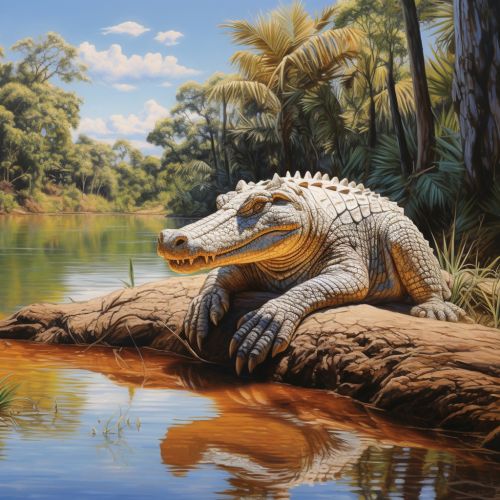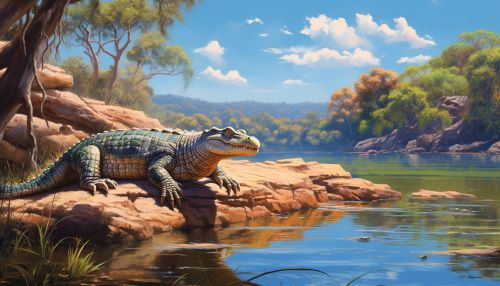Crocodiles
Introduction
Crocodiles are large aquatic reptiles that live throughout the tropics in Africa, Asia, the Americas and Australia. They are members of the order Crocodylia, which also includes caimans, gharials and alligators. This order is characterized by a robust body, a long, muscular tail, a short but strong neck, and a powerful jaw with sharp teeth.


Biology and Anatomy
Crocodiles have a streamlined body that enables them to swim swiftly. They also tuck their feet to the side while swimming, which makes them faster by decreasing water resistance. They have webbed feet which, though not used to propel the animal through the water, allow them to make fast turns and sudden moves in the water or initiate swimming. Webbed feet are an advantage in shallower water, where the animals sometimes move around by walking.
Crocodiles have a palatal flap, a rigid tissue at the back of the mouth that blocks the entry of water. The palate has a special path from the nostril to the glottis that bypasses the mouth. The nostrils are closed during submergence.
Like other archosaurs, crocodiles are diapsid, although their post-temporal fenestrae are reduced. The walls of the braincase are bony but lack supratemporal and postfrontal bones. Their tongues are not free but held in place on the floor of the mouth, so it is not possible to stick them out.
Crocodiles have smooth skin on their bellies and sides, while their dorsal surfaces are armoured with large osteoderms. The armoured skin has scales and is thick and rugged, providing some protection. They are still able to absorb heat through this armour, as a network of small capillaries allows blood through the scales to absorb heat.
Crocodiles are very fast over short distances, even out of water. They have extremely powerful jaws and sharp teeth for tearing flesh, but cannot open their mouth if it is held closed, hence there are stories of people escaping from the long-snouted Nile Crocodile by prising its jaws open.
Behaviour and Habitat
Crocodiles are ambush predators, waiting for fish or land animals to come close, then rushing out to attack. As cold-blooded predators, they can survive long periods without food, and rarely need to actively go hunting. Despite their appearance of being slow, crocodiles are top predators in their environment, and various species have been observed attacking and killing sharks.
Crocodiles are social creatures; they share basking spots and large food sources, such as schools of fish. Very large crocodiles can change their sex, with males becoming females. This behaviour is thought to be a response to a lack of females in the population.
Crocodiles are found in the tropics in Africa, Asia, the Americas and Australia. They live in rivers, lakes, wetlands, and some saltwater regions. They are excellent swimmers and have been known to swim great distances. Larger species can swim up to 20 km (12 mi) in a short time. They have a high resistance to salinity, surviving near saltwater or brackish water. They can also tolerate low oxygen levels.
Conservation Status and Threats
Crocodile populations are sensitive to changes in the environment, and are considered good indicators of environmental health. Many species are at risk from habitat destruction and pollution, and several are listed as vulnerable or critically endangered.
Illegal hunting for skins and meat also poses a significant threat to crocodile populations in many parts of the world. Conservation efforts include farming crocodiles for their skins, with the aim of reducing the demand for wild-harvested products, and reintroducing farmed crocodiles into the wild.
